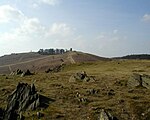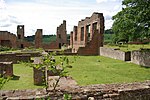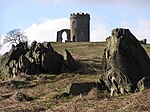Sheet Hedges Wood

Sheet Hedges Wood is in the parish of Newtown Linford, and lies some 1-mile (1.6 km) north of Groby, in Leicestershire, UK. The site is made up of two areas of woodland and a meadow field, all with public access, extending 29 acres (120,000 m2). The woodland block is adjacent to the road includes a car park and access trails. The larger eastern woodland is a 21.7 hectares (54 acres) biological Site of Special Scientific Interest. It is typical of ancient woods on clay soils in central and eastern England, and ash is dominant in the canopy, while the shrub layer has hazel, field maple, hawthorn, elder and privet.Between the two woodland blocks, the fields have had some broadleaved tree planting, and encouragement of natural regeneration. An area of meadow is also managed as a wildflower hay meadow.The wood and meadow are managed by Leicestershire County Council. Less than 1 kilometre (0.62 mi) south is Groby Pool, an area of natural open water, with its own car park. 1 kilometre (0.62 mi) north, accessed via a footpath or Groby Lane, is Bradgate Park, a large deer park and open public space.
Excerpt from the Wikipedia article Sheet Hedges Wood (License: CC BY-SA 3.0, Authors, Images).Sheet Hedges Wood
Groby Lane, Hinckley and Bosworth Groby
Geographical coordinates (GPS) Address Nearby Places Show on map
Geographical coordinates (GPS)
| Latitude | Longitude |
|---|---|
| N 52.674052777778 ° | E -1.2287083333333 ° |
Address
Groby Lane
Groby Lane
LE6 0HH Hinckley and Bosworth, Groby
England, United Kingdom
Open on Google Maps









